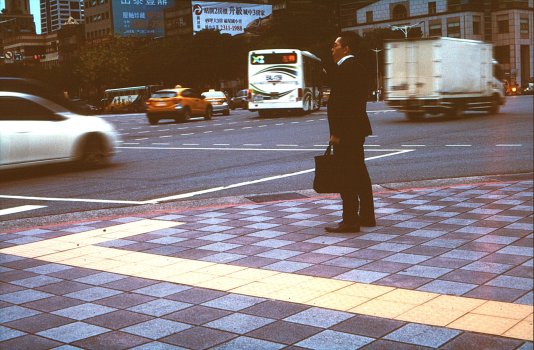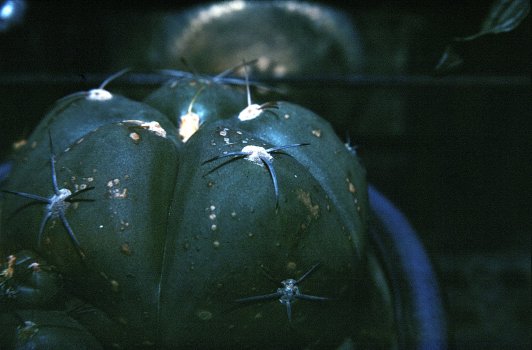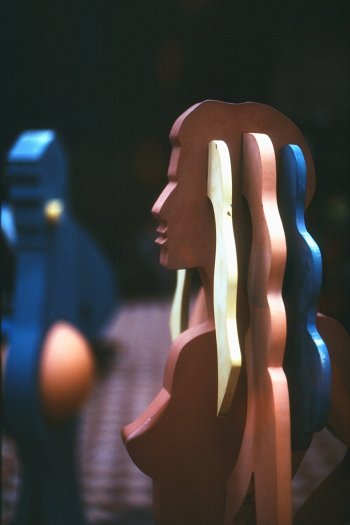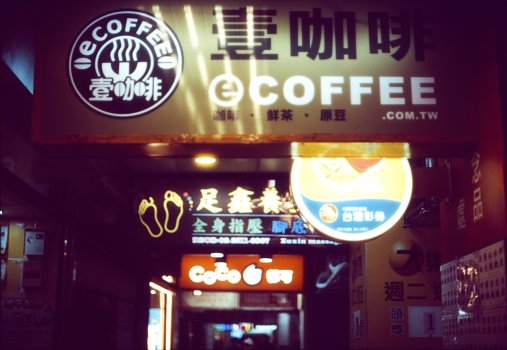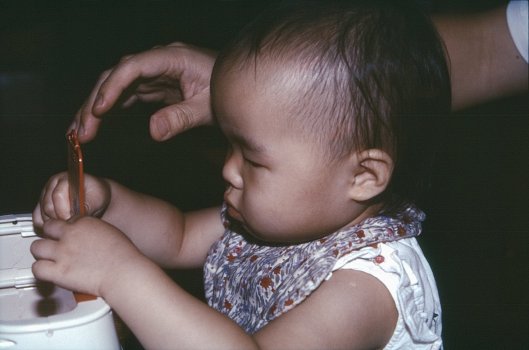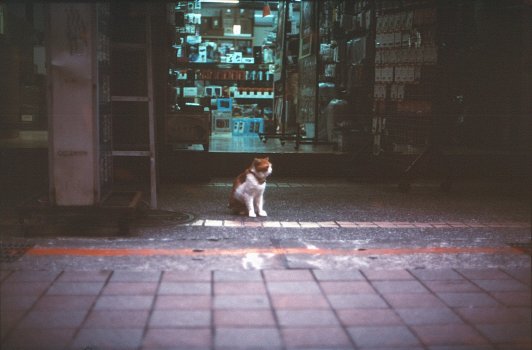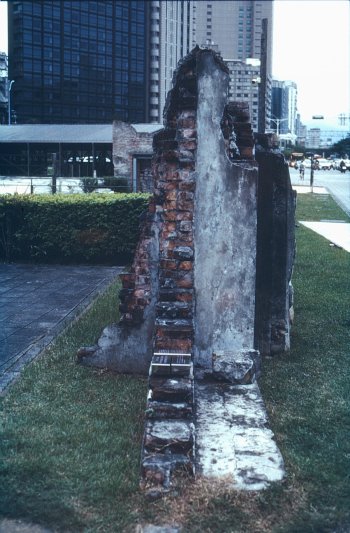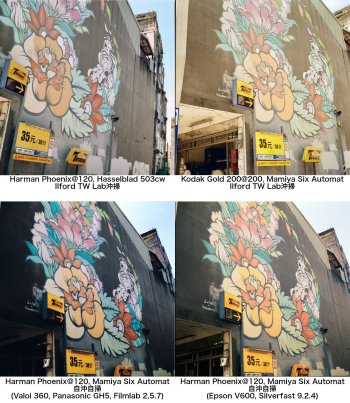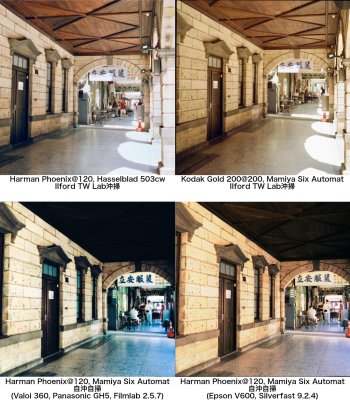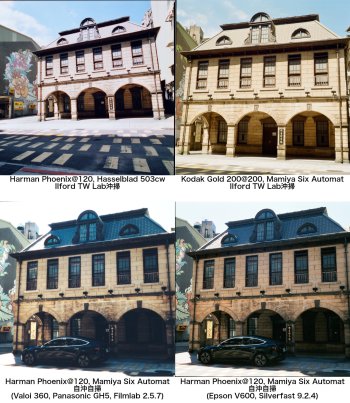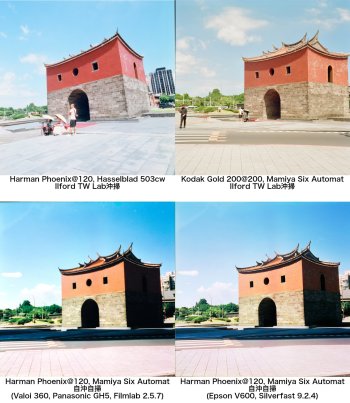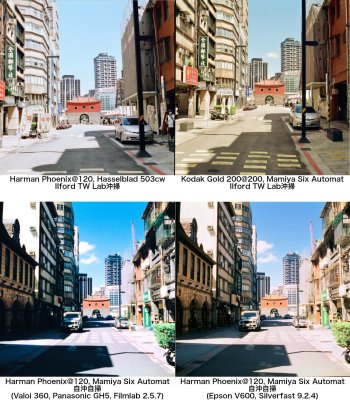I thought I'd share some of my further adventures with Harman Phoenix. I've been fooling around with reverse processing ordinary negative film lately, but of course negative film in C-41 chemistry produces an orange tinted base, so color correcting the scans was a major PITA. Then it occurred to me, Harman Phoenix has a clear base, so it might produce a better result. Well, here's my first full roll of reverse processed Harman Phoenix, and I'd say it ended up pretty well considering all I used was just normal b&w and C-41 chemistry. The attached image is simply the developed film placed on a lightbox and shot with my iPhone 15 Pro.

Got a tip for us?
Let us know
Become a MacRumors Supporter for $50/year with no ads, ability to filter front page stories, and private forums.
Can we talk about film?
- Thread starter mollyc
- Start date
- Sort by reaction score
You are using an out of date browser. It may not display this or other websites correctly.
You should upgrade or use an alternative browser.
You should upgrade or use an alternative browser.
I thought I'd share some of my further adventures with Harman Phoenix. I've been fooling around with reverse processing ordinary negative film lately, but of course negative film in C-41 chemistry produces an orange tinted base, so color correcting the scans was a major PITA. Then it occurred to me, Harman Phoenix has a clear base, so it might produce a better result. Well, here's my first full roll of reverse processed Harman Phoenix, and I'd say it ended up pretty well considering all I used was just normal b&w and C-41 chemistry. The attached image is simply the developed film placed on a lightbox and shot with my iPhone 15 Pro.
View attachment 2387893
I've only developed BW so far, although bought C41 chemicals and the Cinestill temperature thing last week. Still need to get some bottles to mix up the chemicals. All of which to say that I haven't attempted color dev yet.
But, did you use E6 processing for this, and just pretended it was slide film? Otherwise, what does reversal process mean? Could we see a full image with final edits?
"Reversal" in this sense means producing a positive image on film—in other words, "reversing" the negative, which is what the E-6 process does. The normal E-6 process involves two development stages (first development in b&w, second development in color) and either re-exposure to light or a fogging bath (which simply uses chemistry to "expose" the film). I've done roughly the same, just with my usual b&w and C-41 chemicals instead of standard E-6 chemistry.I've only developed BW so far, although bought C41 chemicals and the Cinestill temperature thing last week. Still need to get some bottles to mix up the chemicals. All of which to say that I haven't attempted color dev yet.
But, did you use E6 processing for this, and just pretended it was slide film? Otherwise, what does reversal process mean? Could we see a full image with final edits?
My process was as follows:
1. Overexpose by two stops when shooting. (For Harman Phoenix, this means shooting at ASA 50.)
2. All following steps are done at normal C-41 temperature, i.e. 38℃/100℉
3. Develop the film first in b&w chemistry, for this I used my usual HC-110 dilution B, but with 12 minutes intermittent agitation at 38℃, which is both way longer and hotter than usual b&w film development, to ensure that this stage produces a dense negative.
4. After b&w development, dump the liquid out, and take the film out of the tank and off of the reel to re-expose to light. I held it about 60 cm/2 feet away from a lamp, and exposed both sides for about one minute each. Then put the film back onto the reel and into the tank.
5. Finally, follow all steps of the normal C-41 procedure: color dev, bleach, fix.
Of course, the results can't be compared to something like Ektachrome since I used neither real slide film nor E-6 chemicals, but I think some of the photos turned out much better than I expected. As with real slide film, though, exposure tolerance is much lower than shooting normal negative film.
Attachments
I've only developed BW so far, although bought C41 chemicals and the Cinestill temperature thing last week. Still need to get some bottles to mix up the chemicals. All of which to say that I haven't attempted color dev yet.
I've got an Anova sous vide circulator which I used with the Cinestill CS41 chemicals. It's a short develop and a much longer fix (well, bleach and fix) compared to B&W, and if you're inverting the tank you have to make sure to let some air out after pouring in the blix otherwise it will leak. But other than that it's super easy if you've done B&W before! I just did my third batch through it today, and this time I used the spinner stick that came with the Patterson tank instead of inverting which was way less fuss! And it seems to have worked just as well, so I'd probably recommend that for C41.
The other nice thing about C41 vs B&W is that it's the same development time for all films, unless you're pushing/pulling. Which means if you have a two roll tank like I do you can develop a roll of Portra and Gold together, or a 160 speed with an 800 speed, etc. So much more convenient than black and white, where if you shoot a roll of 400 and a roll of say 3200 they have to be developed separately one at a time.
For the bottles, I just got the collapsible CineStill ones. They're easy to let all the air out for storage, and then when you let the air back in they float nicely upright in the water bath. I had been pretty intimidated by C41 vs black and white, but I'm glad I gave it a try!
My local lab is closing in October. They haven't publicly announced yet, but are telling people when they are in the store. He's announcing publicly next month and I have my fingers crossed that maybe someone will come in and buy it, but I know that's a long shot. So I kind of have to learn color processing now because I've been spoiled by having the lab just two towns over.I've got an Anova sous vide circulator which I used with the Cinestill CS41 chemicals. It's a short develop and a much longer fix (well, bleach and fix) compared to B&W, and if you're inverting the tank you have to make sure to let some air out after pouring in the blix otherwise it will leak. But other than that it's super easy if you've done B&W before! I just did my third batch through it today, and this time I used the spinner stick that came with the Patterson tank instead of inverting which was way less fuss! And it seems to have worked just as well, so I'd probably recommend that for C41.
The other nice thing about C41 vs B&W is that it's the same development time for all films, unless you're pushing/pulling. Which means if you have a two roll tank like I do you can develop a roll of Portra and Gold together, or a 160 speed with an 800 speed, etc. So much more convenient than black and white, where if you shoot a roll of 400 and a roll of say 3200 they have to be developed separately one at a time.
For the bottles, I just got the collapsible CineStill ones. They're easy to let all the air out for storage, and then when you let the air back in they float nicely upright in the water bath. I had been pretty intimidated by C41 vs black and white, but I'm glad I gave it a try!
I have read about the spinner stick vs inverting and really I just need to get my collapsible bottles and a bin for the sous vide thing, although I could probably scrounge up an existing bin in my house if I spent five minutes looking. My daughter is ahead of me in this game and has done color processing at school, so she can hold my hand the first go round if I need, but I think I can probably manage with some tutorials I have saved. I bought a "press kit" from Omega Brands for the chemicals, but it's my understanding that all the c41 kits are pretty much the same thing. I think I will run a dummy roll though my Holga as a test run for development once I order my accordian bottles. I'm not trusting myself to dev my monthly rolls until I have a couple of other ones under my belt first!
If you have a good agitation technique for B&W you will be fine with C-41
The main difference is that while I generally try not to get developer on my clothes, I really try not to get drops of bleach on them! And as I learned the hard way my typical B&W agitation technique worked fine for actual developing, but let a bit of bleach get onto my shirt…
Have not reviewed the various kits. Technically it may be possible to combine bleach and fix steps, but I would certainly prefer to keep them separate. There is no harm in increasing bleach time a bit, but cutting it short could result in silver not being entirely removed.My local lab is closing in October. They haven't publicly announced yet, but are telling people when they are in the store. He's announcing publicly next month and I have my fingers crossed that maybe someone will come in and buy it, but I know that's a long shot. So I kind of have to learn color processing now because I've been spoiled by having the lab just two towns over.
I have read about the spinner stick vs inverting and really I just need to get my collapsible bottles and a bin for the sous vide thing, although I could probably scrounge up an existing bin in my house if I spent five minutes looking. My daughter is ahead of me in this game and has done color processing at school, so she can hold my hand the first go round if I need, but I think I can probably manage with some tutorials I have saved. I bought a "press kit" from Omega Brands for the chemicals, but it's my understanding that all the c41 kits are pretty much the same thing. I think I will run a dummy roll though my Holga as a test run for development once I order my accordian bottles. I'm not trusting myself to dev my monthly rolls until I have a couple of other ones under my belt first!
The bleach bath converts the exposed silvers back to a form that will be removed by the fix so this step is super critical for long term stability of the neg.
Blix(combined bleach+fix) has been super common in press kits for...well...ever. Tetenal was doing it back in the 80s or maybe earlier.Have not reviewed the various kits. Technically it may be possible to combine bleach and fix steps, but I would certainly prefer to keep them separate. There is no harm in increasing bleach time a bit, but cutting it short could result in silver not being entirely removed.
The bleach bath converts the exposed silvers back to a form that will be removed by the fix so this step is super critical for long term stability of the neg.
Chemically there's no reason why it won't work, although separate bleach+fix is certainly preferable both for control and long term stability. In fact, as far as compatibility, in the "official" Kodak ECN-2 formula(which they have published, unlike for C-41 and E6), both the bleach and the fix specify the same pH(6.5), and there's nothing that stands out to me that would be incompatible if they were mixed together. ECN-2 of course is not C-41, but the two processes are very similar and there are plenty of people out there who use ECN-2 in place of C-41. There are even some really promising results using HC110 followed by optical fogging and then ECN-2 to develop E6.
Still, though, I've done E6 using Blix(in the Arista.edu kit) and it still looks great 10 years later, so I'm not sure if it's as fatal as some would think. It certainly makes like easier.
Since both bleach and fix are done to exhaustion, and generally the process time errs on going too long, not completely bleaching or fixing isn't really a serious concern provided that you're not stretching your chemistry too long.
Another argument against blix is you need separate bleach and fixer to do a bleach bypass if you're weird like me and like to do weird stuff… although of course you could just use b&w fixer in this case, since they're the same thing.
While on this topic, a word of caution for those just getting their toes wet in C-41: even though color and b&w fixer are the same thing, once a fixer has been used for regular color development (i.e. dev+bleach+fix), DO NOT use it for b&w development ever again, since it may contain traces of bleach, and thus you'll likely end up with completely blank b&w film!
While on this topic, a word of caution for those just getting their toes wet in C-41: even though color and b&w fixer are the same thing, once a fixer has been used for regular color development (i.e. dev+bleach+fix), DO NOT use it for b&w development ever again, since it may contain traces of bleach, and thus you'll likely end up with completely blank b&w film!
Another recent experiment:
I've been poking around some film photography forums and saw people speculating that Lomography 800 is the same as Kodak GT 800-5 (aka Gold 800, Ultramax 800) that's currently only available in Kodak-branded disposable cameras, but I haven't seen anyone do an actual side-by-side comparison. Since I happen to have two Nikon F4 cameras on hand, I thought I'd do one myself. I loaded one F4 with a roll of Lomo 800, and another with a roll of Kodak 800 taken from a disposable camera, then used the exact same 50mm f/1.4 lens and a tripod to take some test photos using the exact same settings on both cameras. After shooting a few frames, I then cut the two film strips out and developed them at the same time, in the same development tank. Finally, I put the two strips in a preserver and scanned them as a contact sheet; I'll do a proper scan later, since the film strips are incredibly curled and I need a day or two to flatten them out. In the attached image, Lomo 800 is on top, Kodak 800 is at the bottom. I think the results speak for themselves: these two evidently don't look the same.

I've been poking around some film photography forums and saw people speculating that Lomography 800 is the same as Kodak GT 800-5 (aka Gold 800, Ultramax 800) that's currently only available in Kodak-branded disposable cameras, but I haven't seen anyone do an actual side-by-side comparison. Since I happen to have two Nikon F4 cameras on hand, I thought I'd do one myself. I loaded one F4 with a roll of Lomo 800, and another with a roll of Kodak 800 taken from a disposable camera, then used the exact same 50mm f/1.4 lens and a tripod to take some test photos using the exact same settings on both cameras. After shooting a few frames, I then cut the two film strips out and developed them at the same time, in the same development tank. Finally, I put the two strips in a preserver and scanned them as a contact sheet; I'll do a proper scan later, since the film strips are incredibly curled and I need a day or two to flatten them out. In the attached image, Lomo 800 is on top, Kodak 800 is at the bottom. I think the results speak for themselves: these two evidently don't look the same.
Pentax announced their new camera yesterday! I just watched a video on it, and it looks way more fun than I expected. I already have a half frame, but it's kind of leaky (which I could probably fix) and also doesn't have a working meter (but I can meter externally).
I'm not going to be on the pre-order train for this, but will definitely keep an eye out for more reviews as they make their way into the wild. It seems like a better built camera than the Polaroid i-2 (which is obviously not in the same genre) for relatively the same price.
I'm not going to be on the pre-order train for this, but will definitely keep an eye out for more reviews as they make their way into the wild. It seems like a better built camera than the Polaroid i-2 (which is obviously not in the same genre) for relatively the same price.
Finally coming in with my May grids. Took me forever to finish my last roll - I just wasn't feeling it. And of course once i got it back I had a ton of images I liked; but for most of the month I was just shooting a single image a day. Have picked up the pace on my current roll, which feels good, but mostly it's just flowers that I'm also shooting on digital. 🙈
Anyway, here we are.
Leica M3, a combo of a Leica 3.5cm lens (first four and a half rows) and a 5cm lens (from row four, image four on), Kodak Color Plus

Leica M3, all Leica 5cm lens (some of the images on this roll rolled to June, so not shared here yet), Kodak Ultramax

We bought the boy child a 30 year old stick shift car which is now a project car with his dad, hence the prevalence of the red hatchback. This car was such a steal, and my husband subsequently found a reddit post talking about it and how people wanted to make an offer on it, but it was already sold! But they've replaced the wheels and 18 year old tires already and have a bunch of other stuff on order to soup it up a bit. You'll see photo of that in the June grid.
Anyway, here we are.
Leica M3, a combo of a Leica 3.5cm lens (first four and a half rows) and a 5cm lens (from row four, image four on), Kodak Color Plus
Leica M3, all Leica 5cm lens (some of the images on this roll rolled to June, so not shared here yet), Kodak Ultramax
We bought the boy child a 30 year old stick shift car which is now a project car with his dad, hence the prevalence of the red hatchback. This car was such a steal, and my husband subsequently found a reddit post talking about it and how people wanted to make an offer on it, but it was already sold! But they've replaced the wheels and 18 year old tires already and have a bunch of other stuff on order to soup it up a bit. You'll see photo of that in the June grid.
You can do just about anything with film. If you want high resolution full color images, you go with med or large format film. If you want gritty lo-fi shots you can shoot 110 cameras and film from Lomography. If you want to tinker and play with extremely fine photography machines the likes of which no one will ever produce again, you have your choice of 50 years of 35mm camera production from the Rollei 35 to the Nikon F6, and every kind of lens ever made to fit all those cameras at massively reduced prices. You can get caught up in the "sharpness" game and go for clarity, resolution & dynamic range, you can decide you like the painterly effects of the medium and accentuate them, you can make archival glass plates for future generations to marvel at or polaroids that come and go quickly, you can simply capture your images on slide or neg for your master archives and spend years improving your digitization techniques pulling more and more image & color info out of them, never printing them at all. There is almost no limit to what you can do with film as a medium.
For 35mm I like to shoot with Nikon FA's (bc they're manual but have modern Matrix Metering built in). You can print it as large as a billboard. You'll see the film grain and know it's an image that was shot on film, just like you'll see the canvas texture through a painting and the stone texture or welds on a sculpture. If you want to go huge dynamic range and /or resolution proof, there are gigabit & grainless films (though it can get a bit uncanny valley seeing a photo without grain) and developing methods like dr5 for that too now.
Developing is an annoyance since we're used to instant gratification. However, the gratification of a phone picture is quick but fleeting. The delayed gratification of waiting until you finish a roll, send it off, forget what you shot, and then sometime later it comes back from developing at dr5 as a surprise of finished images you physically possess is much greater and permanent. I don't waste film on snapshitting, that's what a phone camera is for. But when the light is just right or you know you're going somewhere special you want to preserve on physical media, because those are images people will actually want to look at again, that's where the film camera comes out.
Re: slides vs neg, negatives are generally technically superior to slide films, but I prefer slides for other reasons. A slide is sort of like a little faberge egg, & like a jewel. Hold it up, let some light through it, and there's a whole world in there that lights right up. And after a while you realize the value in those slides, you're not looking at a 2nd or 3rd generation inversion, or reproduction of the original image, you're looking at the original image, an actual artifact of the light in that moment hitting the chemistry and fossilizing the image, and as the same light from the sun now passes through it, it continues that images journey into your eyeballs just as it was in the moment. The slide becomes the thinnest temporal frame between you and the scene. Old slides are a bit like time capsules. There's a real tangible effect they have that is somewhat unique in the entire history of imagemaking. Your kids will one day inherit the images of their youth. Inheriting a load of slides is a bit of a nightmare, but unlike digital photos which are easy to ignore, slides will actually get looked at and sorted through, and as the kids hold them up to the light to see themselves with you that day decades ago on the beach, each slide becomes an undeniable physical sensory connection to themselves and you in that very real moment in time. Pretty powerful stuff.
For 35mm I like to shoot with Nikon FA's (bc they're manual but have modern Matrix Metering built in). You can print it as large as a billboard. You'll see the film grain and know it's an image that was shot on film, just like you'll see the canvas texture through a painting and the stone texture or welds on a sculpture. If you want to go huge dynamic range and /or resolution proof, there are gigabit & grainless films (though it can get a bit uncanny valley seeing a photo without grain) and developing methods like dr5 for that too now.
Developing is an annoyance since we're used to instant gratification. However, the gratification of a phone picture is quick but fleeting. The delayed gratification of waiting until you finish a roll, send it off, forget what you shot, and then sometime later it comes back from developing at dr5 as a surprise of finished images you physically possess is much greater and permanent. I don't waste film on snapshitting, that's what a phone camera is for. But when the light is just right or you know you're going somewhere special you want to preserve on physical media, because those are images people will actually want to look at again, that's where the film camera comes out.
Re: slides vs neg, negatives are generally technically superior to slide films, but I prefer slides for other reasons. A slide is sort of like a little faberge egg, & like a jewel. Hold it up, let some light through it, and there's a whole world in there that lights right up. And after a while you realize the value in those slides, you're not looking at a 2nd or 3rd generation inversion, or reproduction of the original image, you're looking at the original image, an actual artifact of the light in that moment hitting the chemistry and fossilizing the image, and as the same light from the sun now passes through it, it continues that images journey into your eyeballs just as it was in the moment. The slide becomes the thinnest temporal frame between you and the scene. Old slides are a bit like time capsules. There's a real tangible effect they have that is somewhat unique in the entire history of imagemaking. Your kids will one day inherit the images of their youth. Inheriting a load of slides is a bit of a nightmare, but unlike digital photos which are easy to ignore, slides will actually get looked at and sorted through, and as the kids hold them up to the light to see themselves with you that day decades ago on the beach, each slide becomes an undeniable physical sensory connection to themselves and you in that very real moment in time. Pretty powerful stuff.
Last edited:
I love you write up above. However I in my option I think Slide (transparency film) is superior to negative film. I spent a good part of my life working in a Pro Color Lab and printed, scanned and developed all sorts of film. I have seen a lot and I think if exposed properly a color transparency can yield the sharpest print and the best scan. But photography is very subjective and I know many people think the opposite and for their use case they are probably right. 😀Re: slides vs neg, negatives are generally technically superior to slide films
I've been picking away at a response for a few days now, but hadn't had a chance to get my thoughts fully together.
To me, there's not one better than the other. I fall on the side of preferring slides, but there are plenty of downsides to shooting them especially in 2024. The film is expensive, the selection of emulsions is limited(granted that's true of all films...), processing is more expensive, processing is harder to find, good processing is even more difficult to find(especially as there's more chance for things to go wrong) and home processing is longer, more involved, and more fiddly.
Modern C41 emulsions are really darn good. The current Portra films, as I understand it, share technology with Vision 3 pretty heavily, so are arguably some of the most advanced films out there(and Vision 3 has Hollywood money behind it). They have a ton of dynamic range-on par if not better than a lot of digital cameras-and are super easy to scan. Ektar is a little more fussy, but still a great film.
I tried to find some information on grain, but Kodak seems to have changed their method of evaluating grain on color negative films. The old method was RMS Granularity, and the best slide films I'm aware of(Provia 100F and Kodak E100/E100G/E100GX-AFAIK E100 really is just E100G with some tweaks for longer shelf/storage life without refrigeration) have an RMS Granuality of 8. Fuji Velvia(RVP)/Velvia 50(RVP-50)(the former is the "original" Velvia, the latter the relaunch on the new base but allegedly the same) has an RMS granuality of 9 from what I remember. Without looking it up, I seem to remember that the other Velvia offerings(RVP-100, no more in the US, and RVP-100F, gone for good I think) are 9 also. Astia(RAP) was/is 9.
I tried to dig back and find datasheets for the previous generation of Portra also(160NC, 160VC, 400NC/VC/UC) and all it lists too is the print grain index.
I did find something interesting, though. Fuji NPS, which I think would be roughly comparable to Portra 160NC/current Portra 160, lists its RMS Granularity as 3. That makes me wonder if they measure print film the same way...
Whatever the case, I come back to slide film for two reasons. The first is the color. Ektar 100 is close, but I've never found that I can get quite the same colors from Ektar as I can from E100 or Provia, much less Velvia. Slide film also gives you an absolute color reference-you can lay it on the light table and see exactly what it looks like. The second is that I love direct viewing of it, something you can't do with any other film.
I remember back in 2005 or so shooting my first roll of Velvia(and at that point in the US, there really was only one Velvia). I'd dropped it off at The Film Lab in Lexington, KY, which guaranteed same day processing if they got it before 10:00AM. I killed time around town, went back at 2:00, and they handed me two Printfile pages of mounted slides that I put on the light table their in the lobby. I'd not seen anything like it before, and I was hooked from there.
To me, there's not one better than the other. I fall on the side of preferring slides, but there are plenty of downsides to shooting them especially in 2024. The film is expensive, the selection of emulsions is limited(granted that's true of all films...), processing is more expensive, processing is harder to find, good processing is even more difficult to find(especially as there's more chance for things to go wrong) and home processing is longer, more involved, and more fiddly.
Modern C41 emulsions are really darn good. The current Portra films, as I understand it, share technology with Vision 3 pretty heavily, so are arguably some of the most advanced films out there(and Vision 3 has Hollywood money behind it). They have a ton of dynamic range-on par if not better than a lot of digital cameras-and are super easy to scan. Ektar is a little more fussy, but still a great film.
I tried to find some information on grain, but Kodak seems to have changed their method of evaluating grain on color negative films. The old method was RMS Granularity, and the best slide films I'm aware of(Provia 100F and Kodak E100/E100G/E100GX-AFAIK E100 really is just E100G with some tweaks for longer shelf/storage life without refrigeration) have an RMS Granuality of 8. Fuji Velvia(RVP)/Velvia 50(RVP-50)(the former is the "original" Velvia, the latter the relaunch on the new base but allegedly the same) has an RMS granuality of 9 from what I remember. Without looking it up, I seem to remember that the other Velvia offerings(RVP-100, no more in the US, and RVP-100F, gone for good I think) are 9 also. Astia(RAP) was/is 9.
I tried to dig back and find datasheets for the previous generation of Portra also(160NC, 160VC, 400NC/VC/UC) and all it lists too is the print grain index.
I did find something interesting, though. Fuji NPS, which I think would be roughly comparable to Portra 160NC/current Portra 160, lists its RMS Granularity as 3. That makes me wonder if they measure print film the same way...
Whatever the case, I come back to slide film for two reasons. The first is the color. Ektar 100 is close, but I've never found that I can get quite the same colors from Ektar as I can from E100 or Provia, much less Velvia. Slide film also gives you an absolute color reference-you can lay it on the light table and see exactly what it looks like. The second is that I love direct viewing of it, something you can't do with any other film.
I remember back in 2005 or so shooting my first roll of Velvia(and at that point in the US, there really was only one Velvia). I'd dropped it off at The Film Lab in Lexington, KY, which guaranteed same day processing if they got it before 10:00AM. I killed time around town, went back at 2:00, and they handed me two Printfile pages of mounted slides that I put on the light table their in the lobby. I'd not seen anything like it before, and I was hooked from there.
June film grids
Leica M3 + Kodak Ultramax
stupid light leaks from opening the back too soon on the rewind. have played with that a bit and think i know where i'm going wrong so hopefully it won't happen again.

Nikon F100 + Kodak Pro Image 100
kinda forgot I wasn't shooting digital on the butterfly images and accidentally used burst mode 😂 Most of these were taken with a Lensbaby Velvet 56, but the first few might have been with my 105 macro lens. The LB starts for sure with the sixth image, but perhaps four and five also. I don't really keep track on film. 🙂

Leica M3 + Kodak Ultramax
stupid light leaks from opening the back too soon on the rewind. have played with that a bit and think i know where i'm going wrong so hopefully it won't happen again.
Nikon F100 + Kodak Pro Image 100
kinda forgot I wasn't shooting digital on the butterfly images and accidentally used burst mode 😂 Most of these were taken with a Lensbaby Velvet 56, but the first few might have been with my 105 macro lens. The LB starts for sure with the sixth image, but perhaps four and five also. I don't really keep track on film. 🙂
Last edited:
I managed to get a Pentax 17 a couple of weeks ago. It's a fun little camera. I'm not great at zone focusing, but I'm sure I'll get better. I had hoped the little pictographs would help me because I'm no good at estimating distances, but I still have a bit to go in that regard. Still, it is a super fun camera and I love using it to make diptychs.
I am actually quite impressed with the macro setting. Resolution on half frame of course isn't the greatest, but I get a lot of detail in the macro mode, and the included wrist strap (that I am going to switch out) is a great measuring tool for distance.
Metering, in my opinion, is a little on the underexposed side, but I'm sure that is scene and photographer dependent. But next roll I will probably rate one stop higher and also set the EC up a bit; most of this roll was metered at box speed +2/3.
I also tried my hand at color developing for the first time! It was a lot easier than I thought it would be, and subsequent rolls should go a lot faster now that I have the chemistry made up.
Here is a sample of some of my better pairings from the first roll through, on Portra 400.

I am actually quite impressed with the macro setting. Resolution on half frame of course isn't the greatest, but I get a lot of detail in the macro mode, and the included wrist strap (that I am going to switch out) is a great measuring tool for distance.
Metering, in my opinion, is a little on the underexposed side, but I'm sure that is scene and photographer dependent. But next roll I will probably rate one stop higher and also set the EC up a bit; most of this roll was metered at box speed +2/3.
I also tried my hand at color developing for the first time! It was a lot easier than I thought it would be, and subsequent rolls should go a lot faster now that I have the chemistry made up.
Here is a sample of some of my better pairings from the first roll through, on Portra 400.
I managed to get a Pentax 17 a couple of weeks ago. It's a fun little camera. I'm not great at zone focusing, but I'm sure I'll get better. I had hoped the little pictographs would help me because I'm no good at estimating distances, but I still have a bit to go in that regard. Still, it is a super fun camera and I love using it to make diptychs.
If you don't mind bringing technology into an otherwise fairly analog experience, and you've got an iPhone with the LIDAR, I used a rangefinder app for a while that's extremely accurate and definitely helps you get a general sense of distances. Now I tend to just estimate, and have gotten a lot better! I've got an Olympus Six which is a 6x6 camera with a 60mm f/2.8 lens and no rangefinder. I still can't accurately focus it at f/2.8 without using my phone, but I can at least do better when stopped down! It's crazy they made a camera with such narrow depth of field that isn't a rangefinder!
I also tried my hand at color developing for the first time! It was a lot easier than I thought it would be, and subsequent rolls should go a lot faster now that I have the chemistry made up.
Nice! I had the same thoughts, for some reason I was expecting it to be way harder than it actually was! One thing I did learn the hard way though when my second batch (3rd roll) didn't come out as good as the first, you have to add a bit of time to each subsequent development when re-using the chemicals. Turns out it was just a tad underdeveloped and all of the rolls since then have come out great since I realized my mistake.
Oh this is really helpful info, because I don't think I'd read to add time to subsequent rolls, but that makes a lot of sense.If you don't mind bringing technology into an otherwise fairly analog experience, and you've got an iPhone with the LIDAR, I used a rangefinder app for a while that's extremely accurate and definitely helps you get a general sense of distances. Now I tend to just estimate, and have gotten a lot better! I've got an Olympus Six which is a 6x6 camera with a 60mm f/2.8 lens and no rangefinder. I still can't accurately focus it at f/2.8 without using my phone, but I can at least do better when stopped down! It's crazy they made a camera with such narrow depth of field that isn't a rangefinder!
Nice! I had the same thoughts, for some reason I was expecting it to be way harder than it actually was! One thing I did learn the hard way though when my second batch (3rd roll) didn't come out as good as the first, you have to add a bit of time to each subsequent development when re-using the chemicals. Turns out it was just a tad underdeveloped and all of the rolls since then have come out great since I realized my mistake.
View attachment 2400109
I'll look into a Lidar app, thank you!
Cool 😎I also tried my hand at color developing for the first time! It was a lot easier than I thought it would be, and subsequent rolls should go a lot faster now that I have the chemistry made up.
@piatigorsky I thought I'd move the caffenol/Phoenix convo over here.
I was surprised to read that the photo you posted today was a lab scan. Much better than most lab scans I've seen of that film; it was interesting to read their process for converting.
Here is the caffenol recipe I use. I use the Delta one (first listed) with the cheapest store brand instant coffee at my local grocery store. The Ilford Delta 400 I did at nine minutes with tap water. I risked it this roll and didn't actually take the temperature throughout the process. I normally halve the recipe for 500ml but misread my hand notes and accidentally used twice the amount of coffee so then doubled everything else and had way too much developer. Oh well. When I was collecting supplies I couldn't find powdered Vitamin C, so I have tablets that I crush in a mortar and pestle. I know it's all chemistry and needs to be really precise, but I am not a chemist or precise and it all seems to work out okay.
I've used the Cinestill monobath, Ilford Isolfol 3, and caffenol, and I honestly prefer caffenol out of all of those. I am not a prolific bw photographer, so haven't done a ton of experiments, but I really like caffenol for my photos, and really get a kick out of being able to say that I've developed in coffee. It's just such a random thing to tell people.
I was surprised to read that the photo you posted today was a lab scan. Much better than most lab scans I've seen of that film; it was interesting to read their process for converting.
Here is the caffenol recipe I use. I use the Delta one (first listed) with the cheapest store brand instant coffee at my local grocery store. The Ilford Delta 400 I did at nine minutes with tap water. I risked it this roll and didn't actually take the temperature throughout the process. I normally halve the recipe for 500ml but misread my hand notes and accidentally used twice the amount of coffee so then doubled everything else and had way too much developer. Oh well. When I was collecting supplies I couldn't find powdered Vitamin C, so I have tablets that I crush in a mortar and pestle. I know it's all chemistry and needs to be really precise, but I am not a chemist or precise and it all seems to work out okay.
I've used the Cinestill monobath, Ilford Isolfol 3, and caffenol, and I honestly prefer caffenol out of all of those. I am not a prolific bw photographer, so haven't done a ton of experiments, but I really like caffenol for my photos, and really get a kick out of being able to say that I've developed in coffee. It's just such a random thing to tell people.
The lab is part of Ilford’s official reselling company here in Taiwan, and it definitely looks like they know their stuff—at least for Harman Phoenix, I’d say they do a better job than what I’m able to do. They did say that they experimented a lot with how to scan Phoenix when it first launched last year, and in the end they found that scanning as a positive + converting in Photoshop produced the best results. (I’m not sure if they use Negative Lab Pro in Photoshop, or if they have their own presets—I’m going back on Monday, and I think I’ll ask them about it.) This was actually the first time I’ve used their processing and scanning service, even though I‘m a regular customer for film and dark room supplies, and a frequent participant in their photo walks around Taipei.@piatigorsky I thought I'd move the caffenol/Phoenix convo over here.
I was surprised to read that the photo you posted today was a lab scan. Much better than most lab scans I've seen of that film; it was interesting to read their process for converting.
Here is the caffenol recipe I use. I use the Delta one (first listed) with the cheapest store brand instant coffee at my local grocery store. The Ilford Delta 400 I did at nine minutes with tap water. I risked it this roll and didn't actually take the temperature throughout the process. I normally halve the recipe for 500ml but misread my hand notes and accidentally used twice the amount of coffee so then doubled everything else and had way too much developer. Oh well. When I was collecting supplies I couldn't find powdered Vitamin C, so I have tablets that I crush in a mortar and pestle. I know it's all chemistry and needs to be really precise, but I am not a chemist or precise and it all seems to work out okay.
I've used the Cinestill monobath, Ilford Isolfol 3, and caffenol, and I honestly prefer caffenol out of all of those. I am not a prolific bw photographer, so haven't done a ton of experiments, but I really like caffenol for my photos, and really get a kick out of being able to say that I've developed in coffee. It's just such a random thing to tell people.
In terms of the photo walk yesterday, about a week earlier they started advertising a medium format camera-only photo walk for a “mystery film”, which of course some of us correctly suspected to be 120 format Phoenix. (I was actually hoping it might have been some of that IMAX format Double-X that Kodak produced for Christopher Nolan to use, and they somehow managed to get their hands on some of it and cut it down to 120 size!) In any case, I brought with me a Hasselblad 503cw to load with the Phoenix, and also my Mamiya Six Automat that I loaded with Kodak Gold 200, since I wanted to compare how the two films perform. After processing and seeing our results, I immediately bought a second roll of Phoenix to load in the Mamiya, since when we looked at our photos, I found that those in our group who used a camera dating from before C41 color film was available had markedly different color performance than more recent cameras such as the Hasselblad 500 or Pentax 67 series. For this third roll, I tried to retrace my morning route and shoot roughly in as many of the same locations as possible so as to do a comparison, although of course the lighting was different in the afternoon. This third roll I then took home to process and scan myself, but after I found digitization using my digital camera produced weird results, I brought out my scanner to do another pass. (I’ve put my Epson V600 scanner away ever since I got the full Valoi 360 camera scanning system, since the scanner’s CCD is starting to have some issues due to age, and camera scanning is simply much faster, especially if you’re shooting as many as five or six rolls each week!)
I’m posting my side-by-side comparisons here. For those who don’t read Chinese, the top two pictures in each set came from rolls developed and scanned by Ilford Taiwan Lab, and the bottom two I developed myself and then scanned twice, once with a camera scanning setup, and once with a flatbed scanner. This is of course not a fully scientific comparison, since the lighting situation, cameras, and lenses were not completely identical, but I think it’s informative nonetheless.
Also, if anyone is ever in Taiwan, do give Ilford Taiwan Lab a visit. It’s located right in the center of Taipei, and there are lots of scenic spots close by, both antique and modern, that are perfect for shooting both b&w and color film.
I’ve only tried Caffenol once, in a workshop maybe about five years ago, and since we used Caffenol that was prepared for us, I haven‘t tried mixing a batch myself. I recently got a friend interested in b&w darkroom, so next time we’re definitely going to give Caffenol a go ourselves—last time we met I told her about how you can develop film with instant coffee, and her eyes immediately lit up!
Attachments
I think it is very clear, even from the reduced-resolution scans that the flatbed scanner is better. I think because the flatbed does not have a lens. Shooting a negative with a camera is kind of like what enlargers used to do, add one more pass of optical degradation. I see both blur and color artifacts. Also, the Hasselblad optics seem to be a little betterI’m posting my side-by-side comparisons here. For those who don’t read Chinese, the top two pictures in each set came from rolls developed and scanned by Ilford Taiwan Lab, and the bottom two I developed myself and then scanned twice, once with a camera scanning setup, and once with a flatbed scanner. This is of course not a fully scientific comparison, since the lighting situation, cameras, and lenses were not completely identical, but I think it’s informative nonetheless.
It would be fun to see what a Hasselblad digital back looks like side-by-side. (not that an amatuer could ever afford one.)
All that said, the use of medium format is wasted when you past low-res images online. I think this is whey people use cell phones now. If the final image is reduced to one or two megapixels jpg ad vied on a phone screen, the iPhone camera is overkill.
Indeed, there isn't much point in shooting/scanning at high resolutions if the result is only going to be shared online and viewed on a computer or phone screen, and not everyone will want to open TIFF image files that are 70+MB each. I do occasionally prints from my digital scans, in addition to making b&w prints in the darkroom, so for my own personal use I do need as much resolution as possible.I think it is very clear, even from the reduced-resolution scans that the flatbed scanner is better. I think because the flatbed does not have a lens. Shooting a negative with a camera is kind of like what enlargers used to do, add one more pass of optical degradation. I see both blur and color artifacts. Also, the Hasselblad optics seem to be a little better
It would be fun to see what a Hasselblad digital back looks like side-by-side. (not that an amatuer could ever afford one.)
All that said, the use of medium format is wasted when you past low-res images online. I think this is whey people use cell phones now. If the final image is reduced to one or two megapixels jpg ad vied on a phone screen, the iPhone camera is overkill.
For the Phoenix scans, the flatbed scanner results do look much better. But for other rolls of film that I've tried both camera and flatbed scanning, both b&w and conventional color film with an orange base, I can say that the difference is low enough that it really doesn't pay for me to spend the additional 2+ hours using a flatbed scanner to process just one roll of film. In terms of Phoenix though, because of its unconventional base, I haven't quite nailed down what exposure I ought to use when shooting the negatives with a digital camera, plus Filmlab still doesn't have a color negative setting for Phoenix—that said, neither does Silverfast, but I've found its automatic algorithm produces better results.
Oh, and I'm indeed saving up for a Hasselblad digital back, although growing an extra kidney or three to sell on the black market may be a faster solution… Then again, I doubt if there's a copy stand both high enough and sturdy enough to hold a Hasselblad with a lens and an extension tube for macro photography.
Register on MacRumors! This sidebar will go away, and you'll see fewer ads.


